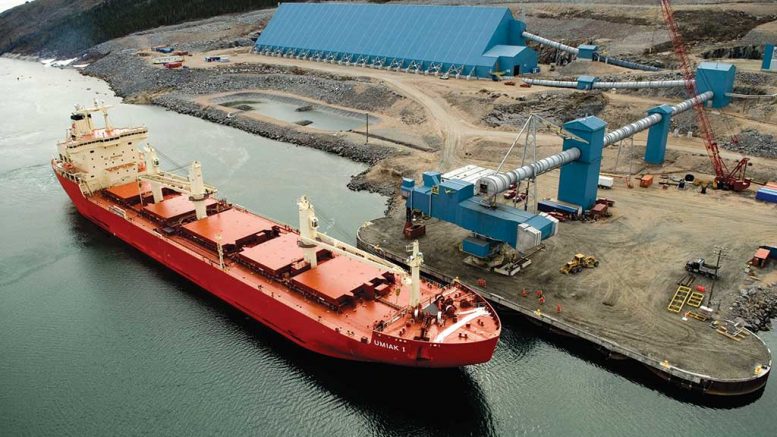In the world’s biggest cobalt stream to date, Vale (NYSE: VALE) has agreed to sell cobalt from its Voisey’s Bay nickel-copper-cobalt mine in northern Labrador to Wheaton Precious Metals (TSX: WPM; NYSE: WPM) and Cobalt 27 Capital (TSXV: KBLT).
The US$690-million, stream-financing deal will help fund 40% of the US$1.7 billion Vale expects to spend on building an underground mine at Voisey’s Bay that will extract ore from two major deposits — Reid Brook and Eastern Deeps — starting in January 2021.
Vale had approved the underground mine-expansion project in July 2015, but difficult market conditions and weak nickel prices forced the company to put the project on hold.
The time is right to resurrect the project, Vale says, with today’s prices for cobalt and nickel rising on the back of anticipated demand for electric vehicles and energy storage. And with most of the world’s cobalt produced as a by-product of copper mining in the Democratic Republic of the Congo, the location of Voisey’s Bay in a good jurisdiction makes it even more attractive.
Under the streaming deal, Vale will receive US$390 million in cash from Wheaton and US$300 million from Cobalt 27 for a combined 75% of future cobalt from Voisey’s Bay (Wheaton will receive 42.4% and Cobalt 27, 32.6%). The two companies will also pay an average 20% of cobalt prices on delivery of the metal.
The first full year of underground production is expected to be 2021, when current open-pit mining winds down. In addition, Voisey’s Bay already has infrastructure, including a state-of-the-art, nickel-copper-cobalt refinery at Long Harbour on the island of Newfoundland, which began operating in 2014 (the cobalt circuit started in 2017).

Vale’s Voisey’s Bay nickel-cobalt-copper mine in Labrador. Credit: Vale.
Wheaton’s share of cobalt production from Voisey’s Bay is forecast to average 2.6 million lb. per year for the first 10 years and 2.4 million lb. per year over the life-of-mine. Operating cash flow to Wheaton at current cobalt prices could average over US$75 million per year for the first 10 years.
“Through Voisey’s Bay, we not only get exposure to the rapidly growing demand for cobalt, we also get exposure to what we believe is the cleanest, most politically stable source of the metal in this world,” Randy Smallwood, Wheaton’s president and CEO, told analysts and investors on a conference call. “Wheaton has and always will be a precious metals-focused company, however, we welcome the opportunity to invest into another low-cost, long-life asset with a partner of Vale’s calibre.”
Voisey’s Bay has total reserves of 32.4 million tonnes grading 2.13% nickel, 0.96% copper and 0.13% cobalt. Of the total, underground reserves contain 23.6 million tonnes at 2.17% nickel and 0.14% cobalt.
Smallwood and his team at Wheaton also see exploration upside.
“There’s great exploration potential, as deeper drilling has already shown that mineralization does continue well below the current resource boundaries,” he said. “We think the life will be longer than the current scheduled reserve base, and we’re very optimistic there.”
A deal of this kind requires a belief in the shift to electric vehicles and more efficient energy storage, Smallwood said, adding that Wheaton is “pretty comfortable in this space.”
Battery chemicals already consume just under half of the world’s cobalt, Wheaton outlined in a press release on the transaction, and that percentage could grow 57% in 2020 and 73% in 2025, with the broader adoption of electric vehicles.
For Cobalt 27 Capital, the Voisey’s Bay news follows an announcement in May that the company has acquired a US$113-million, cobalt-nickel stream from Ramu, a producing nickel-cobalt mine in Papua New Guinea.

Three geologists look toward the Voisey’s Bay open pit mine. Photo by Joshua Duggan (CC 2.0).
Anthony Milewski, Cobalt 27’s chairman and CEO, said the transaction with Vale builds on the Ramu deal and underscores its commitment to add high-quality streams and royalties. “The enhanced exposure to cobalt will yield significant returns to our investors as electric vehicles begin to change our society in the coming years,” he stated.
For Smallwood’s part, Wheaton realized fairly quickly that there were “not a lot of other cobalt projects that we would invest in.
“The cobalt produced at Voisey’s Bay is among the most environmentally friendly, cleanest and conflict-free cobalt in this world,” he said. “There’s going to be a premium for this.”
In addition, as a brownfield project, the mine expansion already benefits from infrastructure, including the existing concentrator, port and support facilities, and the Long Harbour processing plant. “It’s listed as a development project, but I would dare to say that with the operating history and track record of production and processing at the Long Harbour facility, this definitely should be classified as a strong operating asset that will be delivering again in 2021.”
In the meantime, Wheaton will continue to strike streaming deals on precious metal assets, Smallwood said, noting that even after the Vale deal, the company has capacity of more than $1 billion for other transactions, excluding the $500 million in free cash flow annually.
“The market has changed in terms of scale — we’re not seeing the balance-sheet-repair opportunities that we saw three or four years ago,” he acknowledged. “The size of the deals that are out there have shrunk from what we’ve seen three or four years ago, but there is still a lot of opportunity in the precious metals space, and we are hopeful to deliver a couple more transactions this year.”


Be the first to comment on "Vale sells Voisey’s Bay cobalt stream for US$690M"